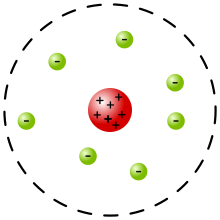
Back Modelo atomico de Rutherford AN نموذج رذرفورد للذرة Arabic Modelu atómicu de Rutherford AST Ruterford atom modeli Azerbaijani Планетарная мадэль атама Byelorussian Модел на Ръдърфорд Bulgarian রাদারফোর্ড পরমাণু মডেল Bengali/Bangla Model atòmic de Rutherford Catalan Rutherfordův model atomu Czech Rutherfordsches Atommodell German

The Rutherford model is a name for the first model of an atom with a compact nucleus. The concept arose from Ernest Rutherford discovery of the nucleus. Rutherford directed the Geiger–Marsden experiment in 1909, which showed much more alpha particle recoil than J. J. Thomson's plum pudding model of the atom could explain. Thomson's model had positive charge spread out in the atom. Rutherford's analysis proposed a high central charge concentrated into a very small volume in comparison to the rest of the atom and with this central volume containing most of the atom's mass. The central region would later be known as the atomic nucleus. Rutherford did not discuss the organization of electrons in the atom and did not himself propose a model for the atom. Niels Bohr joined Rutherford's lab and developed a theory for the electron motion which became known as the Bohr model.